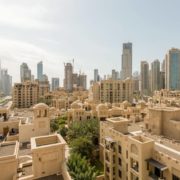DubaiLand
Dubailand is massive residential, entertainment and tourist destination developed by Dubai Properties. It spans 3 million sq. ft. in total and is divided into different residential communities. This large area is located just off Sheikh Mohammed Bin Zayed Road (E311), and many sub-communities are in different stages of completion and maturity. This leads to Dubailand becoming one of Dubai’s most popular areas, as seen in the 2019 Dubai Real Estate Market Report by Bayut. Also, as a freehold district, Dubailand emerged as the third most popular area to buy villas in Dubai.
Dubailand is a loosely used to define the land bank of Dubai Holding Group on Mohammad bin Zayed Road, Al Qudra Road and beyond. As a master-developer, Dubai Holding has sold/parcelled large pieces of land for the development of various themed projects, those include the following:
- Falcon City of Wonders
- Al Habtoor Polo Resort & Club
- Al Barari
- Layan
- Majan
- Sky Court Towers
- Winsdor Residence,
- Villanova,
- Dubailand Oasis,
- Rukan,
- Fiora at Golf Verde,
- The Tiger Woods Dubai
- Living Legends
- The Villa project
- Dubai Sports City
- Motor City
- Al Waha
- Dubai Sustainable City
- Remraam
- Mudon
- Serena
IN A NUTSHELL
- Features a mix of apartments, villas and townhouses
- Sprawls across multiple communities
- The area features over 50 visitor attractions

